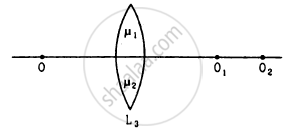Advertisements
Advertisements
प्रश्न
Two lenses A and B have focal lengths of +20 cm and, −10 cm, respectively.
(a) What is the nature of lens A and lens B?
(b) What is the power of lens A and lens B?
(c) What is the power of combination if lenses A and B are held close together?
उत्तर
(a) The focal length of lens A is +20 cm. The positive sign indicates that lens A is convex, i.e., a converging lens.
The focal length of lens B is -10 cm. The negative sign indicates that lens B is concave, i.e., a diverging lens.
(b) Focal length of lens A, fA = +20 cm = +0.20 m
∴ Power of lens `A, P_A=1/(f_A)=1/0.20=5D`
Focal length of lens B, fB = -10 cm = -0.10 m
∴ Power of lens B, `P_B=1/f_b=1/-0.10=-10D`
(c) When lenses are combined, the power of the combination is the algebraic sum of the powers of the individual lenses.
∴ Power of combination of lens A and B,p=P_A=P_B
` P=5D-10D=-5D.`
APPEARS IN
संबंधित प्रश्न
What is the focal length of a convex lens of focal length 30 cm in contact with a concave lens of focal length 20 cm? Is the system a converging or a diverging lens? Ignore thickness of the lenses.
Fill in the following blank with suitable word:
For converging lenses, the power is __________ while for diverging lenses, the power is ___________.
A converging lens has a focal length of 50 cm. The power of this lens is:
Name the type of lens whose power is positive.
The image of an object formed by a lens is real, inverted and of the same size as the object. If the image is at a distance of 40 cm from the lens, what is the nature and power of the lens ? Draw ray diagram to justify your answer.
Consider three converging lenses L1, L2 and L3 having identical geometrical construction. The index of refraction of L1 and L2 are \[\mu_1 \text{ and } \mu_2\] respectively. The upper half of the lens L3 has a refractive index \[\mu_1\] and the lower half has \[\mu_2\] following figure . A point object O is imaged at O1 by the lens L1 and at O2 by the lens L2placed in same position. If L3 is placed at the same place,
(a) there will be an image at O1
(b) there will be an image at O2.
(c) the only image will form somewhere between O1 and O2
(d) the only image will form away from O2.
A pin of length 2.00 cm is placed perpendicular to the principal axis of a converging lens. An inverted image of size 1.00 cm is formed at a distance of 40.0 cm from the pin. Find the focal length of the lens and its distance from the pin.
A 5.0 diopter lens forms a virtual image which is 4 times the object placed perpendicularly on the principal axis of the lens. Find the distance of the object from the lens.
Surabhi from std. X uses spectacle. The power of the lenses in her spectacle is 0.5 D.
Answer the following questions from the given information:
- Identify the type of lenses used in her spectacle.
- Identify the defect of vision Surabhi is suffering from.
- Find the focal length of the lenses used in her spectacle.
What is power of accommodation of eye?
The same size images are formed by a convex lens when the object is placed at 20 cm or at 10 cm from the lens. The focal length of convex lens is ______ cm.
